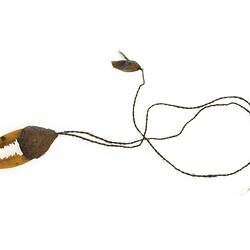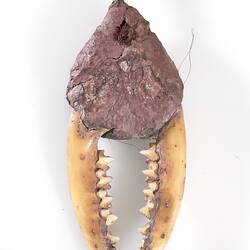Summary
Aboriginal people of central Australia produced a variety of body ornaments for both ceremonial and decorative purposes including headbands, armlets, aprons, pubic tassels, pendants and necklaces like this one. Body ornaments were traded between Aboriginal groups and in some cases were 'sung' to give them certain magical powers. This neck ornament has been made with two mandibles (lower jaws) of small marsupials attached to a string made of human hair with resin, probably made from the leaf stalks of a species of 'Triodia', commonly known as spinifex or porcupine grass. String made from human hair spun on a simple form of spindle was used by some central Australian groups for a range of purposes, including the making of ornaments such as this one. However, the anthropologist Walter Baldwin Spencer (1860-1929) recorded that other Aboriginal groups believed a man's hair could be used to work evil upon him, and were careful to destroy even tiny fragments in case they fell into the hands of an enemy. Animal bones were not uncommon in Aboriginal ornaments in central Australia, with a range of animal parts being used. As well as mandibles, parts included teeth, fur, hawk claws and feathers.
Physical Description
A neck ornament with a pendant made of the lower jaws attached to human hair string with resin. A smaller pendant is also attached on the opposite side and is possibly the Metatarsus of a small marsupial.
More Information
-
Object/Medium
Ornament, neck
-
Maker
-
Cultural Groups
-
Locality
-
Date Produced
-
Collector
-
Date Collected
-
Object Measurements
500 mm (Length), 30 mm (Width), 10 mm (Height)
-
Classification
-
Date Made
-
Maker
-
Clan/Language Group
-
Place Made
-
Indigenous Region
-
Keywords
-
Collection Names
-
Type of item
-
Discipline
-
Category
-
Collecting Areas





